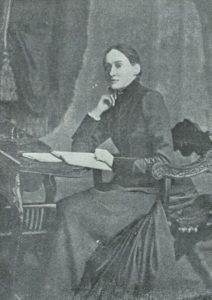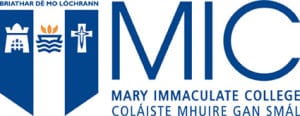Between Two Worlds: Examining “Merry England” as an Outlet for Irish Women Writers
Mary McCartney, University of St. Thomas

In 1885, Katharine Tynan sent a letter to Alice Meynell thanking her for reviewing Tynan’s book Louise de la Vallière and Other Poems in the monthly periodical Merry England (1883–1895). Tynan writes, “It is a beautiful review, and I am glad to have been reviewed by you. […] I value your belief that I am a poet as much” (qtd. in Atkinson 29). Tynan was an Irish nationalist writer who had close ties to W. B. Yeats and was involved in the early years of the Irish Literary Revival. Meynell was a British writer, publisher, and suffragist who co-founded Merry England with her husband Wilfrid in 1883. Most existing scholarship about Merry England is dedicated to the periodical’s contributions to the Catholic Literary Revival, such as Elizabeth Gray’s article “Catholicism and Ideal Womanhood in Fin-de-Siècle Women’s Poetry.” To date, the periodical’s function as a platform for Irish women writers has been largely overlooked. Yet Merry England played an important role in the careers of Irish women writers working in London or submitting work to London publications.
Merry England endeavored to provide London readers with content focused on literature, art, and religion. The periodical’s manifesto reads, “In London alone there are ‘two millions who never smile’… the writers in the new Magazine will, from time to time, invite their readers to consider [a brighter outlook]” (2). The Meynells desired to influence the lives on Londoners. The manifesto further claims, “We spare our readers the trite remark that Literature and Art are great elements of human happiness; but we shall make no apology for recognizing the fact. […] Our Literature shall be literary Literature and our Art shall be artistic Art” (8). It is crucial to keep this statement of intent in mind when considering the role the Meynells played as publishers and editors. They desired to publish Literature with a capital “L” and Art with a capital “A,” and thus they had the utmost belief that the content they published—including content by Irish women writers—would be of the highest quality.
Before looking at specific Irish women writers whose work was published in Merry England, it is helpful to understand the periodical’s tone when addressing Irish themes. In the nineteenth century, the British press was strongly biased against Ireland and Irish culture (de Nie). Merry England fought back by chastising the British press for its caricatures of Irish people (Francis), arguing that some “evil-minded” Englishmen demand Irish subservience (“The Western Question”), and praising Ireland for its faith (“Back to Ireland”). As these examples suggest, Merry England was largely progressive in its views toward Ireland. Thus, it is not surprising that the periodical published work by many Irish women writers, even if its content and readership was largely focused on London.

by W. & D. Downey, published by Cassell & Company, Ltd
carbon print, published 1893
NPG Ax16174
© National Portrait Gallery, London
You can donate to the NPG here
Merry England was a significant platform for Irish women writers. Mary Blundell, who was published under the penname M. E. Francis (1859–1930); Gertrude Elizabeth Campbell (1857–1911); Emily Henrietta Hickey (1845–1924); Clara Mullholland (1849–1934); Rosa Mullholland (1841–1921); and Katharine Tynan (1859–1931) all contributed to the periodical. However, they did not often write on Irish themes. A total of 93 articles, poems, stories, or letters in Merry England include the keyword “Ireland.” Yet fewer than five of these items were written by Irish women. While this avenue of analysis admittedly does not show the whole picture (e.g., articles may be about Ireland but not contain the word Ireland, and some articles were published without bylines), my aim is to illustrate that Ireland was not an explicit topic of focus for Irish women contributors. Thus, the articles in which Irish women do address Ireland are particularly useful for understanding the ways in which women understood their Irish heritage. In the paragraphs below, I examine two such examples: “A House of Roses” by Katharine Tynan and “Off the Coast of Clare” by Gertrude Elizabeth Campbell.

Of all the Irish women contributors to Merry England, Katharine Tynan was the most prolific, publishing a total of 38 articles in the periodical. Of these articles, 35 were published under her maiden name, “Tynan,” and three were published under her married name, “Hinkson.” Nearly all of Tynan’s contributions were poems focused on nature or religion, and she mentions Ireland sparingly. Like Merry England itself, Tynan was caught between two worlds. Whitney Standlee writes, “Post-1893, [Tynan] would often use her work as a means to investigate the position of the individual struggling to reconcile dichotomous consciousnesses: provincial and metropolitan, traditional and modern, Irish and English” (76). Indeed, readers can see this dichotomy in “A House of Roses,” published in Merry England in 1893.
The editorial comment at the beginning of “A House of Roses” illuminates the Meynells’ desire to transform Tynan into a London writer. The comment references Tynan’s forthcoming marriage to an Englishman: “Miss Katharine Tynan is about to change her name for another, and her dwelling-place for another; and the name of Mrs. Hinkson will soon be as prominent in the literary life of London as that of Miss Tynan has been in the literary life of Dublin” (72). The note indicates that one of Tynan’s last pieces to be published under her maiden name was written “from her old home at Clondalkin” (72). Thus, Merry England ties the writer’s maiden name to Ireland and her married name to England. The fact that Merry England publishes the writer under her married name, while most of Tynan’s work was published under her maiden name throughout her career, reflects the periodical’s English aims.
Furthermore, the article itself reveals Tynan’s conflicting cultural ties. “A House of Roses” is about an Irish farm couple whose son, Patrick, leaves Ireland and never returns. His parents wait for him for years until Patrick’s father passes away. It is telling that the editorial comment about Tynan’s marriage is appended to this article. Like Patrick, Tynan departs Ireland. She is eager to immerse herself in the London literary community, even if it means partly leaving her Irish roots behind.
Gertrude Elizabeth Campbell was also a prominent Irish writer in London society. As the art editor of the World from 1889 to 1903, she was the first female editor of a London paper that was not published solely for female readers (Clarke and Sturgeon). Campbell contributed only two articles to Merry England, one of which was a tribute to Ireland. In “Off the Coast of Clare,” Campbell recounts a canoe trip through the caves in County Clare, the birthplace of her father. Her narrative depicts that Irish coast as a magical place: “[The air] seemed to sparkle in the sunlight, as if diamond dust had taken the place of ordinary motes” (369). However, she notes that the coast is under attack: “This Clare coast has made a stern fight for centuries against [the weather], but it has been a losing battle for long, and she is slowly but surely getting the best of it” (370). One can read this description as a metaphor for Ireland in conflict with outside forces. Campbell ends the article by claiming, “Life is worth living after all—when the sun shines on the coast of Clare” (375). If the title Merry England was meant to serve as a nostalgic nod to a time before industrialization, Campbell’s focus on rural Ireland likewise alluded to a simpler time and place, even if it was located outside the boundaries of England.
Tynan’s and Campbell’s writings on Ireland provide a window into the complex nature of Irish women’s contributions to Merry England. While many Irish women writers published their work in the periodical, they were writing for a publication based in London with a largely urban readership; thus, they were caught between two worlds. It is significant that Tynan, as the most frequently published Irish women writer in the periodical, wrote very little about Ireland. And when she did discuss her homeland, the periodical highlighted discontinuity between her British and Irish sympathies. Women writers who, like Gertrude Elizabeth Campbell, praised Ireland unabashedly in their work were published less frequently in the periodical. Thus, while Merry England was pro-Irish and created a space for Irish women writers, it implicitly promoted a metropolitan, English outlook that determined what subject matter they could address.
Mary McCartney is currently pursuing an MA in English at the University of St. Thomas in St. Paul, Minnesota. She is especially interested in twentieth-century British and Irish literature. Her research also focuses on representations of Irish culture in the late Victorian press.
See more about Periodicals here.
Would you like to submit a blogpost? Check out our guidelines here or email Dr Deirdre Flynn.
Works cited
Atkinson, Damian, editor. Selected Letters of Alice Meynell: Poet and Essayist. Cambridge
Scholars Publishing, 2013.
“Back to Ireland.” Merry England, no. 18, 1892, pp. 25-27.
Campbell, Gertrude. “Off the Coast of Clare.” Merry England, vol. 6, no. 36, 1886, pp. 368-375.
Clarke, Frances and Sinead Sturgeon. “Campbell, Gertrude Elizabeth Blood”. Dictionary of Irish
Biography. (ed.) James McGuire, James Quinn. Cambridge, United Kingdom: Cambridge University Press, 2009.
de Nie, Michael. The Eternal Paddy: Irish Identity and the British Press, 1798-1882. Univ. of
Wisconsin Press, 2004.
Francis, M. E. “A Famine of Fun.” Merry England, vol. 7, no. 42, 1886, pp. 382-387.
Gray, F. Elizabeth. “Catholicism and Ideal Womanhood in Fin-de-Siècle Women’s
Poetry.” English Literature in Transition, 1880-1920, vol. 50 no. 1, 2007, p. 50-72.
“Manifesto of Merry England.” Merry England, vol. 2, no. 7, 1883, pp. 7-9.
Standlee, Whitney. “’A World of Difference’: London and Ireland in the Works of Katharine
Tynan.” Irish Writing London: Revival to the Second World War, edited by Tom Herron,
Bloomsbury Publishing, 2012, pp. 70–83.
“The Western Question.” Merry England, vol. 8, no. 48, 1887, pp. 397-410.
Tynan, Katharine. “A House of Roses.” Merry England, vol. 21, no. 118, 1893, pp. 72-76.



